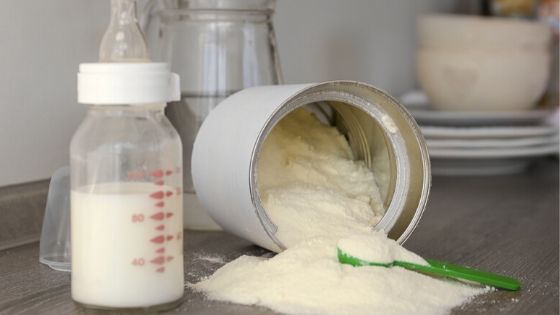Best Organic Infant Formula: Your Guide to choosing the best nourishment for your baby!
With the scary ingredients they put into food these days, there?s no need to reiterate the importance of looking for an organic infant formula to ensure that everything that goes into your baby?s body is good for them and it helps them grow and flourish!
Whether you?re thinking of introducing an additional form of nourishment to your baby as you wean from breast milk, or your little one is staring out on formula feeding, you?ve come to the right place to get the help and advice you need to make that as natural and as nutritious as possible.
How to choose the best organic formula for your baby
Infant formulas come in all sorts of different shapes and sizes, which means, choosing the best one may be a daunting task.
That?s why I?m here to help. Below you?re going to discover what to look for in a baby formula to help you to decide what?s best for both you and your baby.
Let?s begin with base-ics… What makes up the main component of formula? The milk, of course.
1.Understanding the formula base1
There are three main types of formula available: those made from cow?s milk, soy, and protein hydrolysate formulas.
Cow?s milk (dairy)
Why it?s good:
Infant formulas made with cow?s milk is the closest nutritionally speaking to breast milk. Most full-term babies who are not breast-fed respond extremely well to cow?s milk formulas as it naturally contains the right balance of nutrients your baby needs. With additional nutrients manufacturers include in these formulas, it is an easy to digest source of food for a growing baby.
Why you may need to seek an alternative:
Cow?s milk has a high content of various types of milk protein that some little ones are unable to digest, which is why it is one of the most common causes of food allergy. This type of formula will make them quite ill should it continue to be introduced into their diet, as they won?t benefit from the nourishment it provides.2
Soy
Why it?s good:
If your little one can?t tolerate the proteins or sugars found in cow?s milk, soy-based formulas offer useful alternative. Soy is also most nutritionally similar to cow?s milk when it comes to the comparison to plant-based milk sources.3
Why you may need to seek an alternative:
The Mayo Clinic explains that often, babies who are allergic to or don’t tolerate cow?s milk well, may have the same reaction to soy milk. Soy milk is rich in proteins, which may cause upset in some infants should they have an overall problem digestion proteins. Another issue with soy is that most of the soy grown is genetically modified. If your baby tolerates soy, finding an organic infant formula that contains non-GMO sources of soy, is best.
Hydrolysate
Why it?s good:
When your baby has difficulty digesting protein (for example those in cow?s milk and soy milk), this type of formula may be a good option. These formulas contain proteins that have been broken down into smaller, more easily digestible forms and are said to be the best option for babies who need hypoallergenic formula.4
Why you may need to seek an alternative:
If your baby responds well to proteins in milk and milk alternatives, a hydrolysate formula may not be necessary.
Fortunately, manufacturer?s have taken into account the requirements of little ones with more special nutritional needs and this has led to the development of other formula bases, namely goat milk, lactose free varieties and even ones composing of camel?s milk.
Goat milk
Why it?s good:
While there are far fewer available options when it comes to this cow?s milk alternative, goat milk can be a good option to use as a formula. Research shows that goat milk may be more beneficial to your baby?s gut due to the prebiotic fiber it contains, which feeds the beneficial bacteria they have in their digestive tract. 5
Why you may need to seek an alternative:
Babies that react poorly to cow?s milk may also react in the same way to goat milk. While the lactose content is considerably less in goat milk, a hyper-sensitive baby may not fair well with this option. Goat milk may also be less nutritious than cow?s milk, so it is important to look for a fortified organic formula that includes nutrients like folic acid and vitamin D, for example. 6
Lactose free
Why it?s good:
Lactose, a sugar in milk, poses digestion problems for some babies. Lactose needs a special enzyme to break down, and some people are born without the ability to produce enough of it. In this case, lactose has been removed from cow?s milk formulas, where the formula is still able to provide the nutritional content of cow?s milk, without the need to digest the lactose.
Why you may need to seek an alternative:
If your baby does not have a diagnosed problem digesting lactose, you will not require a lactose-free formula. It?s best to seek advice from your healthcare provider regarding lactose intolerance.7
Camel milk
Why it?s good:
The protein content, which is higher in camel milk than cow?s milk, has been shown in one study to be of similar composition to breast milk, which may provide less of an allergic reaction than the former, and it is likely that there is a higher concentration of antimicrobial nutrients in camel milk that add to this feature. Camel milk is lower in the amount of saturated fat but higher in vitamin D than cow?s milk 8,9.
Why you may need to seek an alternative:
Unfortunately, the jury is still out on the use of camel milk in infant formula. Currently, camel milk accounts for only 0.3% of total milk production, and, when compared to cow?s milk at 83%, we can see that it is a very rare commodity. Clinical trials have not yet been conducted on the use or benefits of camel?s milk as a base for infant formula, however, there is promise in its use.10
What should you avoid?
Carrageenan
This red algae extract is often used to stabilize the nutrients in the formula and offers textural benefits, however, even though it sounds natural and has been declared safe for consumption, it may be in your and your baby?s best interests to avoid.
Why?
There?s evidence to show that it causes inflammation – particularly in the digestive tract – in susceptible populations; and babies, because they are still growing and developing, are classified as such.11
Sweeteners and sugars like maltodextrin
Some infant formulas, particularly soy-based ones and hydrolyzed types, contain sweeteners like high fructose corn syrup or other sugars like maltodextrin, which is also a corn-based sweetener. Besides the concerns of corn being GMO, there is evidence to support the role of HFCS in blood sugar and insulin imbalances along with increasing the intensity of developing a sweet tooth.12
Palm oil
This additive is supposedly used to provide the palmitic acid levels that can be found in breast milk. Because palm oil is used, however, it is digested differently and is believed to be associated with some adverse effects, like constipation, for example. Research in the field is still in its infancy? but it?s worth staying away from this ingredient if you can, as some of the effects of hardened stools, colic and other nasty conditions are associated with its intake.13
Synthetic DHA and ARA
The addition of synthetic DHA and ARA (manufactured under the names DHASCO and ARASCO) in infant formulas is mixed.
For one, the chemical structure of the synthetic varieties are slightly different to those found in breast milk, and two, healthy babies can synthesize these compounds from other fatty acids in their bodies.
Unfortunately, even though the long term benefits of these added compounds haven?t been shown, it is difficult these days, to find infants formulas without them.14
In 2011, the National Organic Standards Board allowed the addition of these synthetic fatty acids to be included in organic infant formulas, as long as they weren?t processed using the harmful chemical solvent called hexane.15
Synthetic preservatives and nutrients
The main synthetic preservatives that are added to infant formula are beta carotene and ascorbyl palmitate. They are said to prevent oxidation of the nutrients and prevents it from spoiling.
There is, however, concern about the reaction a little one has to these toxins, which is safer to say, they should be avoided and an organic infant formula, that contains no preservatives is likely to be far better for your baby.
Some formulas have allowed synthetic ingredients to sneak in. Look out for lutein, lycopene, nucleotides, taurine and l-carnitine as they are commonly derived from synthetic sources.
GMO
GMO means genetically modified organisms, which identifies ingredients that have been genetically engineered.
While GMO foods have given rise to feeding thousands of people who would otherwise have no source of nutrition, seeking an organic infant formula that doesn?t make use of foods that are GMO may be better for your little one?s health.
Non-GMO, organic ingredients means that all of the nutrients your baby is ingesting are in their most natural, unprocessed form, which can play a significant role in their little bodies being able to absorb and use them, and possibly increase the tolerance to a multitude of nutrients. 16
At this point, it may feel a bit overwhelming, knowing that there are so many things to look out for in something as seemingly simple as infant formula, that could actually cause harm to your baby, instead of being a pure source of nourishment. That?s why we?re going to get straight into what you can safely feed your infant.
Choosing the best infant formula for your baby:
Organic dairy: When it comes to dairy in infant formula, it?s best to look out for those that contain milk from pasture-raised, grass-fed animals. It means that the likelihood of your baby being exposed to hormones, antibiotics and other toxins through feeding are lower.
Organic whey protein: The same can be said about whey protein. This extracted protein component from whole dairy should follow the same principles. Whey is often used in infant formulas as it is one of the easiest milk proteins to digest, when compared to casein, which is often a cause of digestive issues and associated with a higher occurrence of milk allergies.17
Vegetable/fish oils: Fatty acids obtained from plants that are included in organic infant formulas often come in the form of palm, soy, coconut, safflower and/or sunflower oil. These oils are added as a means to provide the nutrients that breast milk does. Those oils that match the structure of the fats found in breast milk have been shown to increase health of the gut, and reduce gas, colic and constipation.
Lactose: Many formulas use glucose or corn syrup as their source of sugar or carbohydrates, however, the milk sugar called lactose is the one that most closely resembles the carbohydrate found in breast milk. If your baby tolerates lactose, this is an ingredient to look out for instead of glucose or corn syrup.
Certifications: What they mean and why they?re important for choosing the best organic infant formula
Two of the certifications I want to mention here are those that apply to European formula and North American formulas. European standards are particularly high when it comes to agriculture, which some have said makes it a better option when you?re looking for a truly natural and organic infant formula.
European formulas have two distinct certifications: Bioland and Demeter. Look out for products certified with these names as you can trust that they contain dairy from exceptionally well-cared-for cows. These animals are raised on biodynamic farms that follow particularly strict rules set out for the use of pesticides, antibiotics, fertilizers, and hormones. These farms are also required, and committed, to practices of the highest standards that aim to meet and improve sustainability, soil quality, and the ethical treatment of animals.
In North America, while manufacturing practices are highly governed and ingredients used in infant formulas accepted as safe, as a parent I worry about trace amounts of pesticides, GMO ingredients, sugar and other chemicals that are not necessarily regulated.
When it comes to nutritional value, however, there are small differences between the two. As a parent, choice is based on which formula your baby takes best to.
Organic and/or non-GMO organic infant formula – what you need to know
Organic ingredients alone don?t necessarily make an infant formula safe or the best option for your baby. Of course, avoiding synthetic ingredients and non-organic products is a great start, however, there is merit in looking for organic infant formulas that contain non-GMO ingredients, too.
Best organic infant formula:
Holle organic baby formula

This nutritionally complete formula is perfect for your infant of 0-6 months.
It is 99% organic and meets the criteria of the highest organic standards in Europe, with the manufacturer holding the Demeter certification. Demeter is known for its cows raised on biodynamic farms, in a caring and environmentally friendly manner.
Ingredients: Biodynamic Skimmed Milk, Organic Whey Powder (Partly Demineralized), Organic Vegetable Oils [Organic Palm Oil, Organic Rapeseed Oil, Organic Sunflower Oil], Organic Maltodextrin, Biodynamic Organic Milk Powder, Calcium Carbonate, Potassium Chloride, Sodium Chloride, Vitamin C, Vitamin E, Ferrous Lactate, Zinc Sulphate, Niacin, Calcium-d-pantothenate, Copper Sulphate, Vitamin A, Vitamin B1, Vitamin B6, Manganese Sulphate, Potassium Iodate, Folic Acid, Vitamin K, Sodium Selenate, Vitamin D.
Pros: Nutritionally sound formula with no unnecessary additives. It is an ideal alternative or supplement to breast milk.
Cons: It is an imported formula and may be difficult to find.
Lebenswert organic baby formula

This formula is great for babies who are 0-6 months old and is produced by one of the most trusted infant formula manufacturers in Europe, who have over 85 years of experience in the industry.
Ingredients: Organic Skimmed Milk, Organic Whey Powder (Partially Demineralized), Organic Vegetable Oils [Organic Palm Oil, Organic Rapeseed Oil, Organic Sunflower Oil], Organic Lactose, Potassium Chloride, Calcium Carbonate, Vitamin C, Sodium Chloride, Iron Gluconate, Vitamin E, Zinc Sulfate, Niacin, Calcium Pantothenate, Copper Sulfate, Vitamin B1, Vitamin A, Vitamin B6, Folic Acid, Manganese Sulfate, Potassium Iodide, Vitamin K1, Sodium Selenate, Vitamin D.
Pros: This is a German-engineered formula, certified by European Standards. It contains simple ingredients that are 100% natural and GMO-free, plus, it contains none of the nasty ingredients you?ll want to avoid in your organic infant formula.
Cons: None known.
Hipp organic formula

For those of you with little ones that are hypersensitive to the ingredients in their formula, this hypoallergenic organic infant formula.
Ingredients: organic skimmed milk, organic whey product, organic vegetable oils [organic palm oil, organic rapeseed oil, organic sunflower oil], organic starch, galacto-oligosaccharides (obtained from lactose), calcium carbonate, long-chain polyunsaturated fatty acids [fish oil, vegetable oil from mortierella alpina], potassium chloride, l-tyrosine, vitamin C, l-tryptophan, iron sulfate, zinc sulfate, vitamin E, stabilizer lactic acid, natural lactic acid culture [hereditum? lactobacillus fermentum cect5716], niacin, pantothenic acid, cuplex? (copper lysine complex), vitamin A, vitamin B1, vitamin B6, manganese sulfate, potassium iodate, vitamin B2, sodium sulfate, folic acid, vitamin K, biotin, vitamin D, vitamin B12.
Pros: When compared to other pediatrician-recommended hypoallergenic formulas, this organic infant formula contains no sugar, corn syrup or maltodextrin. It also contains probiotics that may benefit your baby?s sensitive gut.
Cons: Some parents have commented that their babies experience an increase in gas production, possibly as a result of the starch it contains.
Baby?s Only Organic Formula
This organic infant formula contains no-GMO ingredients, no corn syrup, and all of the ingredients are said to meet strict USDA Organic Regulations. The toddler formula is intended for babies 1 year and older, and is a good nutritional choice to provide essential ingredients for a growing child.
Ingredients: Organic Brown Rice Syrup, Organic Nonfat Milk, Organic High Oleic Oil (Organic High Oleic Sunflower and/or Organic High Oleic Safflower Oils), Organic Soybean Oil, Organic Coconut Oil, Contains Less Than 1%: Calcium Phosphate, Calcium Ascorbate, Organic Soy Lecithin, Calcium Citrate, Choline Bitartrate, Organic Vanilla, Ferrous Sulfate, Inositol, d-Alpha Tocopheryl Acetate, Zinc Sulfate, Niacinamide, Vitamin A, Calcium Pantothenate, Thiamin Hydrochloride, Copper Sulfate, Riboflavin, Pyridoxine Hydrochloride, Folic Acid, Phylloquinone, Potassium Iodide, Sodium Selenate, Biotin, Vitamin D3, Vitamin B12.
Pros: This organic infant formula contains no added DHA or palm oil and it has a particularly high whey protein component.
Cons: There are synthetic ingredients included in this formula, one of which is nucleotides, and it contains brown rice syrup.
Happy baby organic formula

From stage 1-3, this organic infant formula offers a product that?s suitable for your baby at various ages. It contains a nutritionally balanced blend of ingredients that includes prebiotics and other important nutrients.
Ingredients: organic lactose, organic nonfat milk, organic palm olein or palm oil, organic soy oil, organic coconut oil, organic high oleic (safflower or sunflower) oil, organic galactooligosaccharides (gos)?, organic whey protein concentrate, less than 1%: fructooligosaccharide (fos)?, choline bitartrate, potassium chloride, organic soy lecithin, calcium hydroxide, mortierella alpina oil?, calcium phosphate, sodium citrate, ascorbic acid, magnesium chloride, crypthecodinium cohnii oil?, potassium bicarbonate, inositol, ascorbyl palmitate, ferrous sulfate, zinc sulfate, mixed tocopherol concentrate, vitamin e (dl-alpha tocopheryl acetate), niacinamide, calcium pantothenate, cupric sulfate, vitamin a palmitate, riboflavin, thiamine hydrochloride, pyridoxine hydrochloride, manganese sulfate, beta-carotene, potassium iodide, folic acid, vitamin k (phytonadione), biotin, sodium selenite, vitamin d (cholecalciferol), cyanocobalamin. contains milk and soy ingredients.
Pros: Lactose is the first ingredient listed in this organic infant formula, it contains no corn syrup or maltodextrin, and there are no synthetic ingredients included.
Cons: The formula contains soy, which some little ones may be sensitive to, as well as algae-derived DHA.
Designed By Nature Goat Milk Formula
This organic infant formula is a combination formula made from goat and cow?s milk.
Ingredients: Organic Goat Milk Powder, Sweet Dairy Whey, Organic Coconut Oil, Organic Cod Liver Oil, Organic Olive Oil, Organic Sunflower Oil, Acerola Powder, Lactose, Gelatin, Nutritional Yeast, Protease Enzyme Complex.
Pros: This formula contains no soy, corn, GMOs, artificial sweeteners, food dyes or pesticides.
Cons: The formula contains coconut oil, which some babies may not tolerate well.
Kabrita Goat Milk Formula
For little ones older than 12 months, this formula is said to be both gentle on baby?s digestive system and easily accessible.
Ingredients: skimmed goat milk, lactose (milk), vegetable oils (coconut oil, rapeseed oil, sunflower oil), high sn2 palmitic acid oil, goat whey protein concentrate powder (milk), galacto-oligosaccharides (GOS) (milk), minerals (calcium carbonate, tri potassium citrate, tri sodium citrate, tri calcium phosphate, potassium hydroxide, sodium chloride, magnesium chloride, potassium chloride, ferrous sulphate, zinc sulphate, copper sulphate, manganese sulphate, potassium iodide, sodium selenate), marine oil containing DHA (fish), choline bitartrate, arachidonic acid-rich oil (AA), vitamins (sodium L-ascorbate, L-ascorbic acid, DL-? tocopheryl acetate, niacinamide, calcium D-pantothenate, riboflavin, thiamin hydrochloride, retinyl acetate, pyridoxine hydrochloride, folic acid, phytomenadione, cholecalciferol, D-biotin, cyanocobalamin), L-phenylalanine, taurine, inositol, L-carnitine.
Pros: It is a popular formula with many parents because of the tolerance to its ingredients, it contains a higher percentage of whey, and includes a special type of palm oil that has been shown to improve stool consistency.
NANNYcare First Infant Milk
This premium goat milk formula is based on ingredients suitable for babies starting from birth. NANNYcare is one of the only companies that invest in research around goat milk infant formulas.
Ingredients: pasteurised goat milk solids, lactose (from milk), vegetable oils (high oleic sunflower, rapeseed, sunflower), minerals, vitamins, acidity regulator (citric acid), choline chloride, antioxidant (sunflower lecithin), l-tryptophan, l-isoleucine, taurine, l-carnitine, antioxidant (tocopherol-rich extract), ascorbic acid, dl-?-tocopheryl acetate, nicotinamide, retinyl acetate, cholecalciferol, calcium d-pantothenate, phytonadione, cyanocobalamin, thiamin hydrochloride, riboflavin, pyridoxine hydrochloride, folic acid, biotin, calcium hydroxide, sodium citrate, potassium chloride, ferrous sulphate, calcium citrate, zinc sulphate, copper sulphate, manganese sulphate, potassium iodide, sodium selenite.
Pros: It is an easy-to-digest formula and can be used to substitute breastfeeding or as a combination feeding option. This formula contains no palm oil.
Cons: It is a non-organic formula.
Best formula for lactose intolerant babies
A lactose-free formula may contain cow?s milk, but the carbohydrate component, which is lactose, has been removed and replaced with another form of sugar. True lactose intolerance is fairly rare, and is diagnosed at birth through screening tests.18
Best formula for colic babies
Hypoallergenic formulas like Hipp Anit Reflux formula may also provide relief, and trying goat milk formulas could be a good option if your baby has colic.
Note: sometimes a dairy allergy can be confused with colic. Be sure to have sensitivities tested for if your little one has severe digestive issues despite trying different formulas.
Conclusion
Looking for the best formula for your little one may seem like a daunting task. Sometimes it involves a bit of trial and error to settle on the one your baby tolerates best. In most babies, however, any organic infant formula with all natural ingredients can provide them with the nutrients they need to grow and flourish.
Sources
- Simcoe Muskoka District Health Unit, Formula Feeding Your Baby: A guide for when you have decided to formula feed your healthy full term baby. 2017.
- Cow’s milk allergy: from allergens to new forms of diagnosis, therapy and prevention. Hochwallner H, Schulmeister U, Swoboda I, Spitzauer S, Valenta R. Methods. 2014 Mar 1; 66(1):22-33
- Review of Infant Feeding: Key Features of Breast Milk and Infant Formula. Camilia R. Martin, Pei-Ra Ling, and George L. Blackburn. Nutrients. 2016 May; 8(5): 279.
- Chung CS, et al. FDA’s health claim review: Whey-protein partially hydrolyzed infant formula and atopic dermatitis. Pediatrics. 2012;130:1.
- Andrea Leong, Zhiqian Liu, Bogdan Zisu, Christopher Pillidge, Simone Rochfort, Hala Almshawit, Harsharn Gill. Oligosaccharides in goat?s milk-based infant formula and their prebiotic and anti-infection properties. British Journal of Nutrition, 2019
- Alberta Health Services. Nutrition Guidelines: Healthy Infants and Young Children. Milk. 2016
- Bosch AM. Classic galactosemia: dietary dilemmas. J Inherit Metab Dis. 2011;34(2):257-60
- Cow?s Milk Substitutes for Children: Nutritional Aspects of Milk from Different Mammalian Species, Special Formula and Plant-Based Beverages. Elvira Verduci, Sofia D?Elios, Lucia Cerrato et al. Nutrients 2019, 11(8), 1739
- Muehlhoff, E.; Bennet, A.; McMahon, D.; Food and Agriculture Organisation of the United Nations (FAO). Milk and Dairy Products in Human Nutrition (2013). Dairy Technol. 2014, 67, 303?304
- Maryniak, N.Z.; Hansen, E.B.; Ballegaard, A.-S.; Sancho, A.I.; B?gh, K.L. Comparison of the Allergenicity and Immunogenicity of Camel and Cow?s Milk?A Study in Brown Norway Rats. Nutrients 2018, 10, 1903
- The Role of Carrageenan and Carboxymethylcellulose in the Development of Intestinal Inflammation. John Vincent Martino, Johan Van Limbergen,and Leah E. Cahill. Front Pediatr. 2017; 5: 96
- Wabitsch M, Posovszky C (eds): Developmental Biology of Gastrointestinal Hormones. Endocr Dev. Basel, Karger, 2017, vol 32, pp 87-99
- Bronsky, J; Campoy, C; Embleton, N; Fewtrell, M; Mis, NF; Gerasimidis, K; Hojsak, I; … ESPGHAN Committee on Nutrition, ; + view all (2019) Palm Oil and Beta-Palmitate in Infant Formula – A Position Paper by the ESPGHAN Committee on Nutrition. Journal of Pediatric Gastroenterology and Nutrition , 68 (5) pp. 742-760
- DHA and ARA addition to infant formula: Current status and future research directions. E., Lien, et al. Prostaglandins Leukot Essent Fatty Acids. 2018 Jan;128:26-40
- Formal Recommendation by the National Organic Standards Board (NOSB) to the National Organic Program (NOP). Docosahexaenoic acid (DHA) algal oil petition. 2011
- Green America. Downsides to GMO infant formula? We asked a Pediatrician. 2013.
- Re-evaluation of the whey protein/casein ratio of human milk. Kunz, C., & Lonnerdal, B. Acta Paediatr. 1992 Feb;81(2):107-12.
- Bosch AM. Classic galactosemia: dietary dilemmas. J Inherit Metab Dis. 2011;34(2):257-60. doi:10.1007/s10545-010-9157-8








